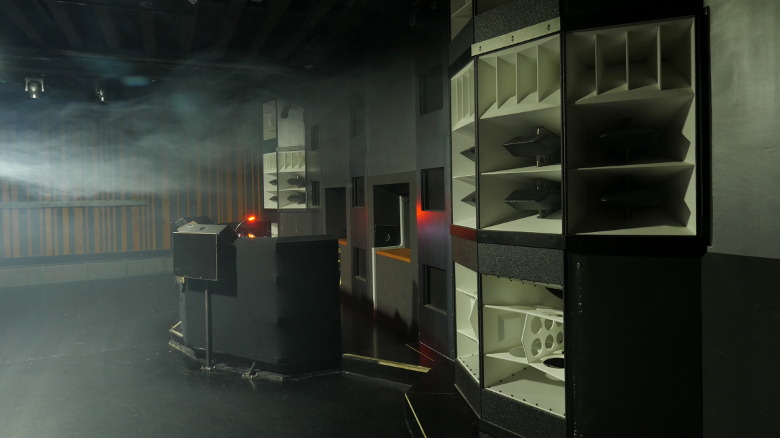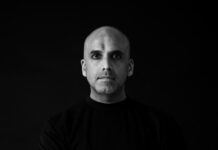Photos: Press/Elysia
First published in Groove 162 (September/October 2016). Translation by Silvano Pinto.
It is a universally acknowledged fact that sound is one of the pillars on which every successful and perhaps legendary club, rests. So, when it came to the conception of the Elysia club in Basel, sound was not just a means to an end, but rather the blueprint according to which the entire dancefloor and PA were customized. In Basel’s new sound temple we sat down with Guy Blattmann, club manager, and Lambda Labs, who are responsible for the groundbreaking speaker concept.
The image of a temple is not randomly chosen. Once you step on the mainfloor, the eyes fall on an enormous wall of speakers: in the midst of this, the DJ desk creates an almost sacral atmosphere. This is no place for parties, this is where sound is celebrated. An elaborate projection mapping directed towards the white polyurethan-coated speakers heightens the effect. In the main room, even a bar has been dispensed with, eliminating anything that might distract from the musical experience. For those who need a quick drink, a tiny, nearly invisible window has been set into the side of the dancefloor.

Fit the room to the system
The managers’ wish to have the DJ desk right in the middle of the long side in a rectangular room left Lambda Labs’ creative heads with several hard nuts to crack. First among these was the stereo imaging: as Lambda Labs’ Steffen Kroschel knows, it is generally very difficult to maintain the spatial image intact along such widths. He further explains that a single horn cabinet of the QX series has a dispersion angle of only 30°. This is usually a highly desired effect in matters of large scale PA, resulting in the fundamental features of this construction, his colleague Reinhard Nell adds: this tight focus allows for a very precise, directed dispersion to carry the energy where it is wanted, meaning into the audience, and only the audience. Distribution partner Wolfgang Sauter solved the problem with an impressive feat of material: with 4 QX-3 cabinets to each side he broadened the dispersion angle to 120°. Along with 4 so called ‘kickfillers’ and a total of 12 subwoofers arranged snugly in three lines along the wall, they flood the room’s 200qm2 with more than 100.000 watts – this would be enough for a hall with 10.000 people. But, as Mr. Sauter explains, it’s not about extreme sound pressure levels, but about sound quality and about the physical impact, that is, the bodily perceptible sound.
„It’s quite an experience for some DJs to have their audience hear literally anything they do.” – Guy Blattmann
When asked about how to approach such a speaker development, Reinhard Nell replies that it starts out as an idea in your head, a vision that becomes reality and settles down: “You lie awake sometimes, get back to your computer and start the simulation over and over again with new parameters taken from an imaginary draft – because it’s all about geometry and wavelengths.” Usually there follows a long phase of development work, calculations, computer generated models and prototypes: “That takes time and that’s exactly the kind of work that leads many other manufacturers to say ‘what the heck, let’s just throw in another double 18″ – take a box, screw in two drivers, fix up three prototypes and let’s see who’s got the best sound'”. It quickly becomes clear during the course of our conversation that Reinhard Nell and Steffen Kroschel speak in terms derived from physics and acoustics which, to the uninitiated, must seem like alchemy. There’s talk of numerical calculations with finite elements, phaseplugs to calibratesurface expansion rates or widening up the dispersion angle as well as ‘amplitude shading’ – a method that originates from radar technology. No doubt about it: these two live and love loudspeakers, horns especially. Horn loudspeakers represent the very height of the craft and it is their acoustic superiority and the indispensable deep understanding that cause this fascination, explains Nell.

Club sound like in a recording studio
The perceptible ease of power, linearity and tonal balance of the speaker system however more than justify the effort. So much indeed that nowhere on the precincts do you have the sensation of standing in a club, but rather in a perfectly customized studio, where even the smallest of the entire production is brought to bear. Unsurprisingly, producers are regular guests, merely wishing to have a reference listening to their tracks, says manager Guy Blattmann. However, he adds that the PA’s relentless precision and exactitude have at times caused problems for some DJs. This would happen when they cannot adapt to this kind of direct and immediate communicating with their audience through the music: “It’s quite an experience for some DJs to have their audience hear literally anything they do.” As an afterthought, a reverberation processor was integrated into the system, to change perceived room acoustics to ‘wet’ if desired. Most DJs however will end up preferring the PA’s raw and compact sound.
Blattmann, who finished a degree in law and is now the Elysia’s manager, is in many aspects a man of rather unvonventional views, which might be taken as an example by many club directors who are more attuned to business matters than to the love of music. His main goal is to give as many DJs as possible an opportunity of playing ‘the instrument’, as he lovingly puts it: “I want us to be diverse, which is reflected accordingly in the wide stylistic range of our booking team.” And although the financial support of potent partners in Basel allows for a reputation built on renowned headliners, Guy Blattmann’s vision is quite another: “Eventually I don’t want people to come to our club just for the DJs, I want them first of all to come for the club itself.” That the club’s atmosphere is very near and dear to the family man Blattmann is evident: “Sometimes, when I get home early and talk to a member of the team on the phone, I don’t say: ‘How many people were there?, I ask: ‘Did the spark leap over?'”




